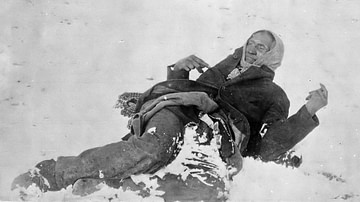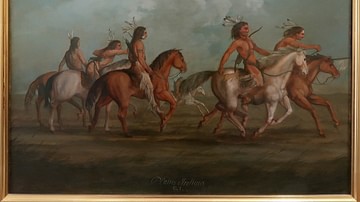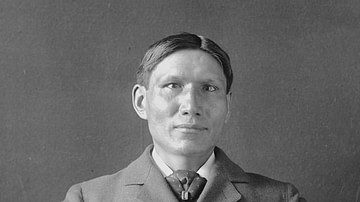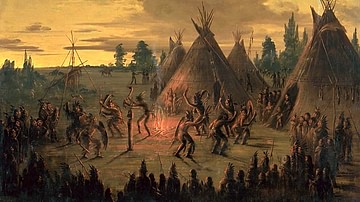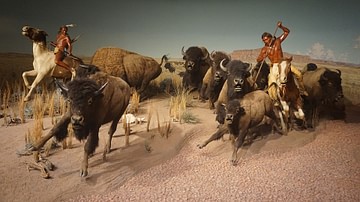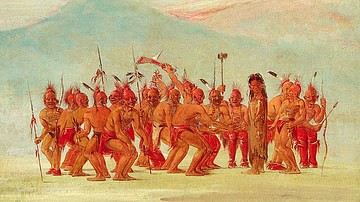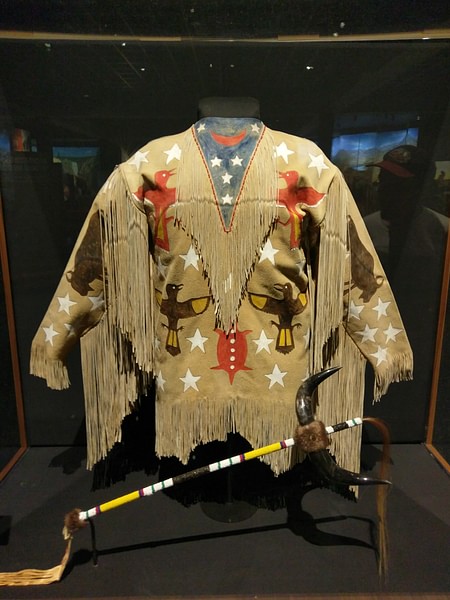
The Ghost Dance (Spirit Dance) is an expression of rebirth and renewal using the traditional Native American circle dance, first practiced by the Paiute Nation in 1869 and again in 1889 when it was adopted by other Plains Indians nations. US government agents' fear of the dance led to the Wounded Knee Massacre of 1890.
Ghost Dance is a mistranslation of the Paiute term for Spirit Dance but has become the name for the dance most recognized. The dance was only one aspect of a larger spiritual movement that included adherence to a moral code of conduct in one's personal and public life which, according to the vision preached by the Paiute prophet Wovoka (also known as Jack Wilson, l. c. 1856-1932), would remove the Euro-Americans and their destructive practices from North America, return the land to the indigenous peoples, resurrect the dead who had been lost to disease or conflict with white people, and bring the buffalo back, all of which would restore the world known by the Plains Indians prior to the European colonization of the Americas.
The movement was originally envisioned by the Paiute medicine man and prophet Wodziwob (d. c. 1872) in 1869, although, according to some scholars, there were earlier versions of the Ghost Dance that influenced this one. Wodziwob's vision, which may have been based on these earlier movements, was far more apocalyptic than Wovoka's later movement. Wodziwob claimed a great earthquake would eliminate everyone, but afterward, those Native peoples who had believed in his words would be resurrected and restored to the land. Among Wodziwob's followers was Numutibo'o, father of Wovoka.
The Ghost Dance was a non-violent, spiritual, response to the genocidal policies of the US government which included forced relocation of indigenous people to arid lands and the systematic slaughter of the buffalo which had traditionally sustained the people of the Great Plains. The US government, however, interpreted the movement as a threat, resulting in the arrest and death of the Sioux Chief Sitting Bull (l.c. 1837-1890) as well as the deaths over 250 others in the Wounded Knee Massacre.
Background of Movement
The Westward Expansion of the Euro-Americans in the early 19th century deprived indigenous peoples of the lands they had lived on for thousands of years, disrupting their way of life and, beginning c. 1840, eliminating the buffalo, which were not only the peoples' major source of food, clothing, and shelter but also had spiritual significance. Military posts such as Bent's Fort, erected in 1832 on the Arkansas River in Colorado, were established to protect white settlers and deal with any Native peoples considered 'hostiles'.
European-borne disease and armed conflict with white settlers and soldiers decreased the population of the Plains Indians nations while agreements with the US government, such as The Fort Laramie Treaty of 1851, took more and more land at the same time that the buffalo were being exterminated and Native children were being taken from their parents and placed in boarding schools to facilitate assimilation. As the Native peoples were facing these increasing threats, Wodziwob received his vision; promising the people a return to their former way of life if they would only adhere to the teachings of the prophet, comport themselves accordingly, and practice the Ghost Dance faithfully.
Wodziwob preached his vision from the time he received it in 1869 until his death in 1872. Among the prophecies attributed to him by his followers was that a train carrying the dead back from the afterlife would arrive among the people within four years. When this train failed to materialize, faith in the movement faltered and then died. Wovoka, son of one of his disciples, then received a new vision along the same lines in 1889.

Wovoka claimed to have conversed with the Great Spirit and had been shown the beautiful land of the blessed dead where they lived in peace, without fear, sickness, or disappointment, on plains full of wild buffalo and other game. As he had been educated by Euro-Americans in Christianity, he articulated what he had been shown through Christian imagery and referenced the return of Jesus as part of his prophecy. He also claimed he would soon reign over the West just as President Benjamin Harrison (served 1889-1893) would continue to over the East.
In his vision, he was told to preach non-violence to the people and, if they refrained from warfare, led moral, upright lives, and performed the Ghost Dance, they would be reunited with all they had lost. Whether this reunion was originally intended to take place in the afterlife is unclear, but it was interpreted to mean the dead would be restored to life and return to their loved ones here on earth, at the same time as the buffalo, and that white settlers would peacefully withdraw and go back to where they had come from.
Spread of the Movement
As Wovoka preached his vision to the Paiute throughout 1889, it attracted the attention of citizens of other Plains Nations including the Caddo, the Cheyenne and Arapaho, the Iowa, Osage, Otoe-Missouria, Pawnee, Quapaw, and the Sioux, among others. The Oglala Lakota Sioux Chief Kicking Bear (l. 1845-1904) visited Wovoka and brought his message back to his people. He also conferred with the great medicine man Sitting Bull, but, contrary to later claims by the US government, Sitting Bull was not the catalyst for the movement nor an early supporter of it.

Representatives of other nations also visited Wovoka and introduced the Ghost Dance to their people. In addition to living moral lives free of lying, stealing, or acts of violence, believers in the Ghost Dance were encouraged to wear a certain type of clothing – known as the ghost shirt – a buckskin shawl, shirt, or coat ornamented with magical symbols.
The shirt may have originated with Wovoka's vision or may have been introduced to the Sioux by Chief Kicking Bear and then been adopted by others. The shirt was supposed to protect the wearer and, it was claimed, could even stop bullets. Whether Wovoka initially suggested the ghost shirt, he encouraged its wear as it promoted the pacifism he understood as the will of the Great Spirit in his vision.
By early 1890, the vision of the Ghost Dance Movement had been embraced by many Native American nations who observed the precepts and participated in the dance. There were those who rejected the movement, however, including the Navajo, who maintain a long-standing policy that the dead should have no commerce with the living and feared the Ghost Dance's promise of the return of the dead.
Two Eyewitness Accounts of the Dance
The Ghost Dance was based on the traditional circle dance (also known as round dance) regularly practiced by the Native peoples of North America in religious rituals or as social events. The circle dance usually includes drums and singing or chanting as dancers revolve around a central object or communal fire.
The Ghost Dance differed from the traditional circle dance in that drums were not always used, only chanting of repeated lines, and there was not always a central focus of a pole (sacred tree) or fire. Dancers would join hands in a circle and move in a side-stepping cadence, with the steps and chanting often speeding up, as the people sought to experience Wovoka's vision of the beautiful land of those who had been lost.

Poet and writer Elaine Goodale Eastman (l. 1863-1953), wife of the Sioux doctor, writer, and activist Charles Eastman, observed the ritual firsthand c. 1889-1890 when she was a teacher in the Dakota Territory and describes it in her memoirs:
There was no secrecy about the dance which had caused such frantic alarm [among the white people]. It was held in the open, with neither fire nor light, after the participants had fasted for a day or two and passed through the purifying ordeal of the sweat lodge. Anyone might look on, and on a bright November night I joined a crowd of spectators near Porcupine Tail Butte – the only person who was not a Sioux.
Under the soft glow of the hunter's moon, perhaps a hundred men, women, and children, with clasped hands and fingers interlocked, swung in a great circle about their "sacred tree", chanting together the monotonous Ghost Dance songs. The hypnotic repetition of the words: "Once more we shall hunt the buffalo – Our Father has said it!" alternated with short invocations by prophet or priest and occasional intervals of wailing by the women – that musical heart-piercing sound which, once heard, is never forgotten. No one with imagination could fail to see in the rite a genuine religious ceremony, a faith which, illusory as it was, deserved to be treated with respect.
"You have your churches; why can we not have ours?" was the natural reaction of the people.
In the course of an hour or two, one of the worshipers would break abruptly from the ring, rush wildly about, and fall in a trance or faint, lying for some time motionless. One old woman fell so near to me that I could have touched her. Presently, she stirred, got to her feet unaided, and addressed the gathering in a strong voice:
"My children, I have seen those dear ones we lost long ago!"
"Ah-h-h! He-ye-ye!" responded the people.
"They are living in a most beautiful country covered with buffalo!"
"He-ye-ye! Ate heye lo!" (Our Father has said it.)
"Their tipis are of skins. They are feasting and playing. They are perfectly happy!" (After each statement, the people intone their deep-voiced response) "Here, everything looks hateful to me – how can I bear it?"
The congregation responds with groans and cries. Then the priest repeats that the Messiah will appear "with the new grass" in the spring and the vision will come true for all believers.
After listening to this strange litany for half the night, I lay down in my tent quite worn out with sympathetic excitement. The spell, or incantation, or rite continued with increasing fervor until dawn.
(Townsend, 143)
Scholar Roxanne Dunbar-Ortiz cites the report given by the Sioux anthropologist Ella Deloria of a first-hand account by a Sioux gentleman who, as a boy, traveled from his village to attend a dance:
Some fifty of us, little boys about eight to ten, started out across country over hills and valleys, running all night. I know now that we ran almost thirty miles. There on the Porcupine Creek, thousands of Dakota people were in the camp, all hurrying about very purposefully. In a long sweat lodge with openings at both ends, people were being purified in great companies for the holy dance, men by themselves and women by themselves, of course…
The people, wearing the sacred shirts and feathers, now formed a ring. We were in it. All joined hands. Everyone was respectful and quiet, expecting something wonderful to happen. It was not a glad time, though. All wailed cautiously and in awe, feeling their dead were close at hand.
The leaders beat time and sang as the people danced, going round to the left in a sidewise step. They danced without rest, on and on, and they got out of breath but still they kept going as long as possible. Occasionally, someone thoroughly exhausted and dizzy fell unconscious into the center and lay there "dead." Quickly, those on each side of him closed the gap and went right on. After a while, many lay about in that condition. They were now "dead" and seeing their dear ones. As each one came to, she, or he, slowly sat up and looked about, bewildered, and then began wailing inconsolably…
Waking to the drab and wretched present after such a glowing vision, it was little wonder that they wailed as if their poor hearts would break in two with disillusionment. But at least they had seen! The people went on and on and could not stop, day or night, hoping perhaps to get a vision of their own dead or at least to hear the visions of others. They preferred that to rest or food or sleep. And so, I suppose, the authorities did think they were crazy – but they weren't. They were only terribly unhappy.
(153-154)
The authorities of the Bureau of Indian Affairs may have thought the dancers were "crazy" but certainly regarded them as a threat. Without bothering to try to understand the ritual, and ignoring the report of experienced Indian Agent and surgeon Valentine McGillycuddy (l. 1849-1939) – which made clear the Ghost Dance was non-threatening and was only a religious observance – acting Indian Agent James McLaughlin (l. 1842-1923) requested more troops deployed to the region and ordered the arrest of Sitting Bull, claiming he was the ringleader of the movement.

US Government Response
Agent McLaughlin was hardly inexperienced. He had been in the region since 1871, served as an agent since 1876, and knew Sitting Bull personally. Still, he interpreted the Ghost Dance as a call to arms and feared an uprising. The Dawes Act of 1887 had recently broken up the Great Sioux Reservation, forcing Native communities onto lots where they were expected to make a living as farmers, and reserving large swaths of land for development by non-Natives. Believing the Ghost Dance was a call for action against these policies, McLaughlin sought to cut the initiative off at what he thought was its source and sent officials to bring in Sitting Bull.
On 15 December 1890, Sitting Bull was killed during the arrest attempt at the Standing Rock Reservation, and the Lakota Chief Spotted Elk (also known as Big Foot, l. 1826-1890), fearing he would be taken next, led his people away toward the Pine Ridge Reservation, intending to appeal to the authorities for a peaceful negotiation.
Spotted Elk's band was overtaken by the 7th Cavalry on 28 December 1890 and forced to make camp near the Wounded Knee Creek. The next morning, during a search-and-seizure operation by the US soldiers for any weapons in the camp, a gun went off and the soldiers surrounding the encampment opened fire, killing upwards of 250 Native people, including Spotted Elk, most of whom were the elderly, the sick, women, and children. The US cavalry suffered a loss of 25 men, most from friendly fire. The event, known as the Wounded Knee Massacre, was termed a 'battle' by the US government, and 20 of the soldiers who participated in it were given the Medal of Honor.
Conclusion
The US government never outlawed the Ghost Dance, as they had the Sun Dance in the 1880s, but the Bureau of Indian Affairs tried, unsuccessfully, to have it banned. Many Native nations stopped the practice after the Wounded Knee Massacre, fearing the same fate, but others continued the dance into the early 20th century. The Pawnee, who had always been on good terms with the United States and had even supplied scouts in their wars against the Sioux, continued the dance, and according to some scholars, this helped to preserve the language and culture.
The United States authorities in 1890 saw the Ghost Dance as a serious threat to stability and the safety of white settlers in the region, but to the people who had lived on that land for centuries, it offered the hope of a return to the world they had known prior to colonization. Writer Stephanie Hall comments:
From an Indian point of view, Europeans were not only destroying the way of life of Indian peoples, but destroying the natural resources of the plains to an extent that would make it impossible for anyone to live there. European Americans often saw the Ghost Dance as irrational. From an Indian point of view, what was being done to them and their way of life was irrational. (3)
Even among those nations, like the Sioux, where the Ghost Dance was no longer observed publicly, the movement continued in secrecy, maintaining traditional beliefs and, as with the Pawnee and others, the language. Today, the Ghost Dance ritual is observed by several nations, notably the Caddo, though what the modern-day vision of the movement entails is known only to participants. Initiatives like the Land Back Movement and the Tanka Fund – working for the return of stolen lands and the repopulation of the buffalo herds, respectively – currently pursue the vision of asserting Native American autonomy, respect, and recognition, echoing the spirit of the Ghost Dance.
